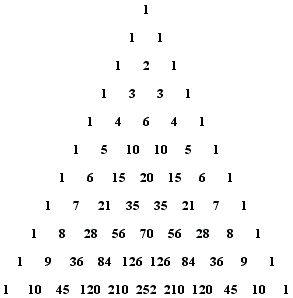What is the binomial theorem?
2 Answers
It is a method one may use to expand a binomial expression raised to a positive integer power as follows :
The combination notation used is defined as follows :
Example :
Expand
This is a binomial (2 terms) raised to an integer power, so the binomial theorem is valid and may be used as follows :
There is a simpler way of expanding a binomial that uses the binomial theorem but takes a more intuitive approach.
Instead of doing
In the case of

The row we want is
#1,5,10,10,5,1#
In order to deal with exponents, know that the exponent on the first term will start at
If there is a negative term they will alternate positive, negative, positive, negative, etc.
For
#1(2x)^5(3y)^0+5(2x)^4(3y)^1+10(2x)^3(3y)^2+10(2x)^2(3y)^3+5(2x)^1(3y)^4+1(2x)^0(3y)^5#
Note that anything to the
Simplified, this gives us
#32x^5+240x^4y+720x^3y^2+1080x^2y^3+810x^4+243y^5#

